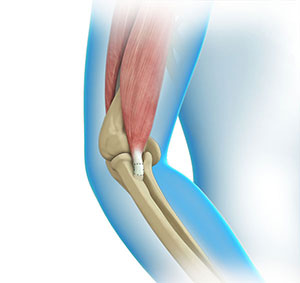
Elbow Anatomy
The elbow is a complex joint of the upper limb formed by the articulation of the long bone of the upper arm or humerus and the two bones of the forearm, the radius and ulna. It is one of the important joints of the upper limb and is involved in basic movements such as flexion and extension of the upper limb and rotation of the forearm.
The elbow joint is supported by the ulnar collateral ligament, radial collateral ligament, and the annular ligament. These ligaments provide stability and strength to the elbow joint.
The elbow joint also has the attachment of the common flexor and common extensor tendons. The groups of muscles, associated with the respective tendons, assist in rotational movement of the forearm as well as the movements of the wrist and hand.
Elbow Injuries
The common conditions affecting the tendons around the elbow joint include tennis elbow and golfers elbow, which result from an overuse injury to the tendons or result from repetitive activities such as sports, mechanical activities or weight lifting.
The ligaments around the elbow may be injured secondary to a sprain, rupture, trauma or an accident. The sprain or trauma may result from repetitive stress, overuse or a direct injury.
Symptoms of Elbow Injuries
The common symptoms of injury to the elbow joint and its surrounding structures include swelling and pain, which may extend from the elbow to the forearm and palm and be aggravated by movements of the wrist. Sometimes, instability of the joint may also be seen.
Elbow Ligament Reconstruction Procedure
Ligament repair or reconstruction is considered in patients with ligament rupture. Your surgeon will make an incision over the elbow. Care is taken to protect the muscles, vessels and nerves. If the ligament can be repaired, it will be re-attached to the bone with heavy suture and bone anchors. If the ligament cannot be repaired, it will be reconstructed with a donor tendon. A donor tendon may be harvested from either the forearm or below the knee. Your surgeon drills holes into the bones of the upper arm and forearm, around the elbow joint. The donor tendon is inserted through the drilled holes in a pattern like that of the original ligament complex. The tendon is then attached to the bone surfaces with special sutures. The incision is closed with sutures and covered with a sterile dressing. A splint is applied to support the elbow for a few weeks. After the surgery, you may be advised for regular follow-up and a rehabilitation program for a quicker recovery.
Risk and Complications of Elbow Ligament Reconstruction
As with all surgeries, elbow ligament reconstruction surgery may be associated with certain risks and complications. The common complications of elbow ligament and tendon repair or reconstruction may include infection, injury to the adjacent nerves or blood vessels, and a loss of strength or flexibility of the elbow joint.
Related Topics
- Open Elbow Surgery
- Distal Biceps Repair
- ORIF of the Humerus Fractures
- Radial Head ORIF and Replacement
- Common Extensor Tendon Origin Repair
- Total Elbow Replacement
- Elbow Arthroscopy
- ORIF of the Coronoid Fractures
- Elbow Ligament Reconstruction
- Elbow Tendon and Ligament Repair
- UCL Reconstruction (Tommy John Surgery)
- Tennis Elbow Surgery
- Ulnar Nerve Release
- Ulnar Nerve Transposition
- ORIF of the Distal Humerus Fractures
- ORIF of the Olecranon Fractures
- Ulnar Collateral Ligament (UCL) Repair with Internal Brace





